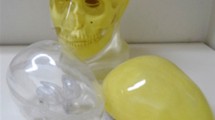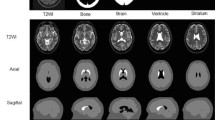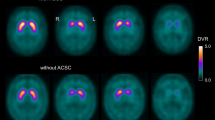Abstract
Purpose
To design a novel algorithm (BasGan) for automatic segmentation of striatal 123I-FP-CIT SPECT.
Methods
The BasGan algorithm is based on a high-definition, three-dimensional (3D) striatal template, derived from Talairach’s atlas. A blurred template, obtained by convolving the former with a 3D Gaussian kernel (FWHM = 10 mm), approximates striatal activity distribution. The algorithm performs translations and scale transformation on the bicommissural aligned image to set the striatal templates with standard size in an appropriate initial position. An optimization protocol automatically performs fine adjustments in the positioning of blurred templates to best match the radioactive counts, and locates an occipital ROI for background evaluation. Partial volume effect correction is included in the process of uptake computation of caudate, putamen and background. Experimental validation was carried out by means of six acquisitions of an anthropomorphic striatal phantom. The BasGan software was applied to a first set of patients with Parkinson’s disease (PD) versus patients affected by essential tremor.
Results
A highly significant correlation was achieved between true binding potential and measured 123I activity from the phantom. 123I-FP-CIT uptake was significantly lower in all basal ganglia in the PD group versus controls with both BasGan and a conventional ROI method used for comparison, but particularly with the former. Correlations with the motor UPDRS score were far more significant with the BasGan.
Conclusion
The novel BasGan algorithm automatically performs the 3D segmentation of striata. Because co-registered MRI is not needed, it can be used by all nuclear medicine departments, since it is freely available on the Web.









Similar content being viewed by others
References
Benamer TS, Patterson J, Grosset DG, Booij J, de Bruin K, van Royen E, et al. Accurate differentiation of parkinsonism and essential tremor using visual assessment of 123I-FP-CIT SPECT imaging: the 123I-FP-CIT Study Group. Mov Disord 2000;15:503–10.
O’Brien JT, Colloby S, Fenwick J, Williams ED, Firbank M, Burn D, et al. Dopamine transporter loss visualized with FP-CIT SPECT in the differential diagnosis of dementia with Lewy bodies. Arch Neurol 2004;61:919–25.
Chouker M, Tatsch K, Linke R, Pogarell O, Hahn K, Schwarz J. Striatal dopamine transporter binding in early to moderate advanced Parkinson’s disease: monitoring of disease progression over 2 years. Nucl Med Commun 2001;22:721–5.
Marek K, Seibyl J, Shoulson I. Dopamine transporter brain imaging to assess the effects of pramipexole vs levodopa on Parkinson disease progression. JAMA 2002;287:1653–61.
Acton PD, Pilowsky LS, Kung HF, Ell PJ. Automatic segmentation of dynamic neuroreceptor single-photon emission tomography images using fuzzy clustering. Eur J Nucl Med 1999;26:581–90.
Acton PD, Mozley PD, Kung HF. Logistic discriminant parametric mapping: a novel method for the pixel-based differential diagnosis of Parkinson’s disease. Eur J Nucl Med 1999;26:1413–23.
Koole M, Laere KV, De Walle RV, Vandenberghe S, Bouwens L, Lemahieu I, et al. MRI guided segmentation and quantification of SPECT images of the basal ganglia: a phantom study. Comput Med Imaging Graph 2001;25:165–72.
Habraken JBA, Booij J, Slomka P, Sokole EB, van Royen EA. Quantification and visualization of defects of the functional dopaminergic system using an automatic algorithm. J Nucl Med 1999;40:1091–7.
Radau PE, Limke R, Slomka PJ, Tatsch K. Optimization of automated quantification of 123I-IBZM uptake in the striatum applied to parkinsonism. J Nucl Med 2000;41:220–7.
Koch W, Radau PE, Hamann C, Tatsch K. Clinical testing of an optimized software solution for an automated, observer-independent evaluation of dopamine transporter SPECT studies. J Nucl Med 2005;46:1109–18.
Talairach J, Tournoux P. Co-planar stereotaxic atlas of the human brain. New York: Thieme Medical, 1988.
Hudson HM, Larkin RS. Accelerated image reconstruction using ordered subsets of projection data. IEEE Trans Med Imag 1994;13:601–9.
Boccacci P, Bonetto P, Calvini P, Formiconi AR. A simple model for the the efficient correction of collimator blur in 3D SPECT imaging. Inverse Problems 1999;15:907–30.
Gelb DJ, Oliver E, Gilman S. Diagnostic criteria for Parkinson’s disease. Arch Neurol 1999;56:33–9.
Deuschl G, Bain P, Brin M; Ad Hoc Scientific Committee. Consensus statement of the Movement Disorder Society on tremor. Mov Disord 1998;13(suppl 3):2–23.
Tatsch K, Asenbaum S, Bartenstein P, Catafau A, Halldin C, Pilowsky LS, et al. European Association of Nuclear Medicine procedure guidelines for brain neurotransmission SPET using 123I-labelled dopamine D2 receptor ligands. Eur J Nucl Med Mol Imaging 2002;29:BP23–9.
Hamann C, Koch W, Radau PE, Tatsch K. Iterative reconstruction or filtered backprojection for quantitative assessment of dopamine d2 receptor studies? J Nucl Med 2003;44:114P.
Koch W, Radau PE, Münzing W, Tatsch K. Cross-camera comparison of SPECT measurements of a 3-D anthropomorphic basal ganglia phantom. Eur J Nucl Med Mol Imaging 2006;33:495–502.
Soret M, Koulibaly PM, Darcourt J, Hapdey S, Buvat I. Quantitative accuracy of dopaminergic neurotransmission imaging with 123I SPECT. J Nucl Med 2003;44:1184–93.
Soret M, Koulibaly PM, Darcourt J, Buvat I. Partial volume effect correction in SPECT for striatal uptake measurements in patients with neurodegenerative diseases: impact upon patient classification. Eur J Nucl Med Mol Imaging 2006;33:1062–72.
Ogawa K, Harata Y, Ichihara T, Kubo A, Hashimoto N. A practical method for position-dependent Compton-scattered correction in single photon emission. IEEE Trans Med Imaging 1991;10:408–12.
Dallal GE. The little handbook of statistical practice. http://www.tufts.edu/~gdallal/LHSP.HTM at the page http://www.tufts.edu/~gdallal/corr.htm
Seibyl JP, Marek KL, Quinlan D, Sheff K, Zoghbi S, Zea-Ponce Y, et al. Decreased single-photon emission computed tomographic [123I]beta-CIT striatal uptake correlates with symptom severity in Parkinson’s disease. Ann Neurol 1995;38:589–98.
Carmack PS, Spence J, Gunst RF, Schucany WR, Woodward WA, Haleyb RW. Improved agreement between Talairach and MNI coordinate spaces in deep brain regions. NeuroImage 2004;22:367–71.
Colloby SJ, O’Brien JT, Fenwick JD, Firbank MJ, Burn DJ, McKeith IG, et al. The application of statistical parametric mapping to 123I-FP-CIT SPECT in dementia with Lewy bodies, Alzheimer’s disease and Parkinson’s disease. NeuroImage 2004;23:956–66.
Van Laere K, Koole M, D’Asseler Y, Versijpt J, Audenaert K, Dumont F, et al. Automated stereotactic standardization of brain SPECT receptor data using single-photon transmission images. J Nucl Med 2001;42:361–75.
Lucignani G, Gobbo C, Moresco RM, Antonini A, Panzacchi A, Bonaldi L, et al. The feasibility of statistical parametric mapping for the analysis of positron emission tomography studies using 11C-2-beta-carbomethoxy-3-beta-(4-fluorophenyl)-tropane in patients with movement disorders. Nucl Med Commun 2002;23:1047–55.
Acknowledgements
The BasGan software has been partially developed with the financial support of GE-Healthcare, Italian Division (Milan), which has also supported translation of the BasGan package instruction manual on the Web from the original Italian version into English. We thank Dr.Enrico Seccamani and Dr. Vincenzo Orlando of GE for following the project since its inception.
Our thanks also go to Dr. Nicola Girtler and Dr. Andrea Brugnolo of the Clinical Neurophysiology Division in Genoa for performing the neuropsychological evaluation in PD patients and to Dr. Arnoldo Piccardo and Dr. Silvia Morbelli at the Nuclear Medicine Dept. of the University of Genoa for acquiring SPECT scans in PD patients and controls.
Finally, we wish to thank Elizabeth Cotton for English editing.
Author information
Authors and Affiliations
Corresponding author
Appendix: PVE correction
Appendix: PVE correction
Activity concentration is considered to be uniform within each compartment. We suppose that PVEs do not produce appreciable cross-talk effects between the left and the right side in activity evaluation and, therefore, that each side can be processed independently.
Relative to one side (e.g. right side), we denote by \(\widetilde{C}\), \(\widetilde{P}\) and B the unknown activity concentrations in the caudate nucleus, putamen and background compartments, respectively. Activity concentration B of the background can be easily evaluated by the ratio of all counts contained in the background ROI over the number of voxels of the ROI itself, since the background ROI is not appreciably affected by PVEs. The value of B is the same for both sides. The problem consists in finding the values of \(\widetilde{C}\) and \(\widetilde{P}\) relative to non-overlapping compartments on the basis of the information derived from a PVE-affected activity map, where the counts contained in a voxel may contain contributions from different compartments.
We denote by c i , p i and b i (i = 1,..., N), respectively, the low-resolution templates of the overlapping compartments caudate nucleus, putamen and background as projected into the image space at the optimal positioning (indeed, index i explores all grabbed voxels in the input activity map, i.e. all voxels targeted by the projection). Moreover, we point out that the background compartment b i (i = 1,..., N) must not be confused with the background ROI used to estimate B. After projecting the templates c i and p i into image space, the background compartment b i is obtained as the complement to unity of the sum c i +p i over the range of all grabbed voxels. Thus the following relation holds:
which can be given the probabilistic interpretation that the grabbed voxel i may contain counts from caudate compartment with probability c i , from putaminal compartment with probability p i and from background with probability b i . Thus, the PVE-affected data v i (i.e. the grabbed voxels of the activity image) contain contributions from the three compartments according to the following relation:
Thanks to the hypothesis that the background receptors are uniformly spread all over the brain, including the striatum, one is interested in the activity concentrations C and P given by:
Finally, the set of equations connecting the experimental data v i with the unknowns C and P are:
whose solution can be estimated by solving the following least-squares problem:
In this way one obtains PVE-corrected estimates for the activity concentrations C and P, from which the ratios C/B and P/B can be derived, respectively denoted as the caudate and putaminal values.
Rights and permissions
About this article
Cite this article
Calvini, P., Rodriguez, G., Inguglia, F. et al. The basal ganglia matching tools package for striatal uptake semi-quantification: description and validation. Eur J Nucl Med Mol Imaging 34, 1240–1253 (2007). https://doi.org/10.1007/s00259-006-0357-2
Received:
Accepted:
Published:
Issue Date:
DOI: https://doi.org/10.1007/s00259-006-0357-2




